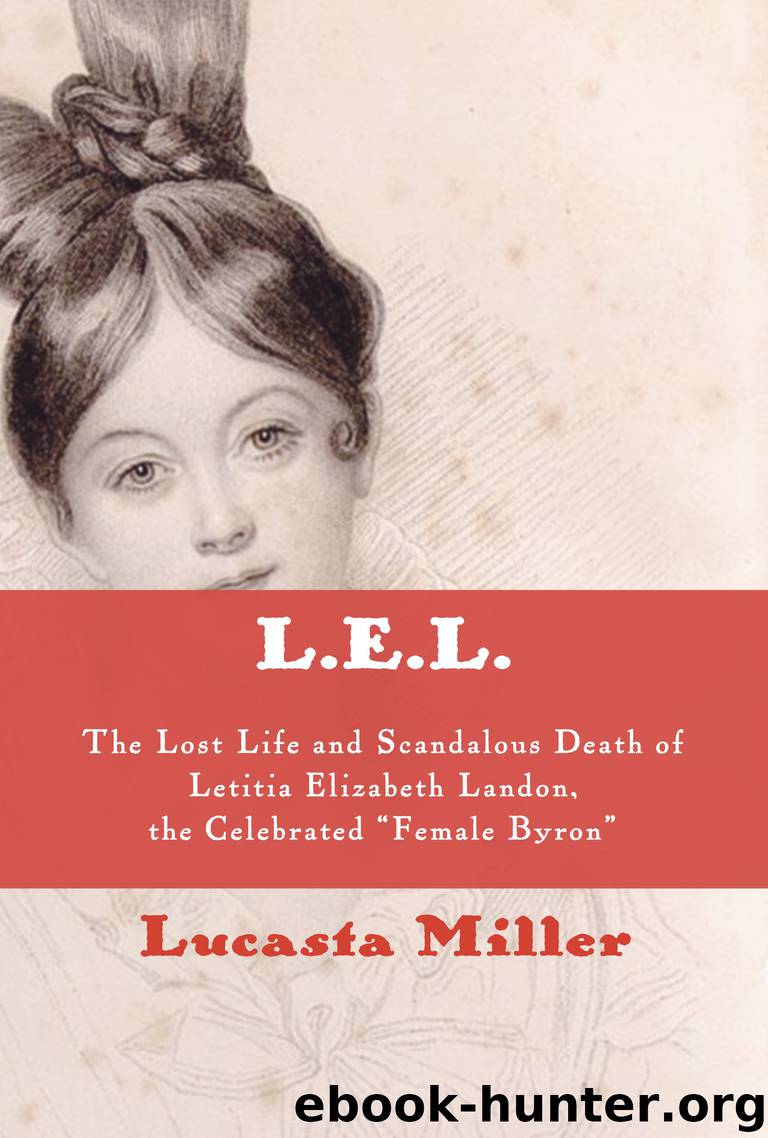L.E.L. by Lucasta Miller

Author:Lucasta Miller [Miller, Lucasta]
Language: eng
Format: epub
Publisher: Knopf Doubleday Publishing Group
Published: 2019-03-04T16:00:00+00:00
The teenage Brontë sisters, painted by their brother Branwell, c. 1834. As outsider readers, they admired both L.E.L. and Fraser’s Magazine, but could not get all its gossipy references.
A “set of coarse men”: the Fraserians by Maclise (undated). Maginn (center) stands over a clutch of bottles, while Jerdan clinks his glass in the foreground with the diminutive Irish antiquary Thomas Crofton Croker.
No periodical did more than Fraser’s to promote an image of the London literati as a raffishly glamorous in-crowd. The Fraserians, as the contributors and their allies called themselves, were a macho lot. In a sketch by Maclise they are portrayed sitting around a table piled with bottles. Jerdan himself is in the foreground, holding up a glass.
The true hold the Fraserians had over Letitia almost certainly was the fact that they had inside information on her sexual history. In throwing in her lot with them, Letitia was making yet another Faustian pact.
Although no letters or diaries exist to document Maclise’s or Maginn’s private relations with Letitia, their public portrayals of her and Jerdan speak volumes if read in context. The most popular series run by Fraser’s was its “Gallery of Illustrious Literary Characters,” a sequence of profiles with texts mainly by Maginn and portraits by Maclise. Jerdan’s vanity must have been tickled by the fact that he made the number 1 slot, ahead of Walter Scott (number 7), Wordsworth (29), Coleridge (37), and Letitia herself (41). The naïve young Brontës, who longed to join the pageant of literary stars, took the series straight, as have many subsequent modern critics. But like L.E.L.’s own poetry, it was more underhand than it appeared.
Placing Jerdan in pole position was an in-joke. The text snidely insinuated he was a has-been by claiming he was born in 1730, which would have made him a hundred years old, while also accusing him of being in hock to Colburn and Longman. Praise for his “just indignation against the vices of society” was a sarcasm, pointed up by Maclise in his accompanying portrait. It showed the “satyr-Cannibal Literary Gazetteer” (to use Carlyle’s phrase) reading a manuscript by the light of an oversized phallic candle that throws a sinister shadow on the wall. His hand is clenched in a fist at his crotch (see plates).
In her Fraser’s profile, Letitia was lavished with unctuous praise for writing on the “feminine” theme of love. At the same time, it implied not only that that the Fraserians considered the pen a male tool, but also that they were metaphorically ejaculating over her:
LETITIA ELIZABETH LANDON! Burke said, that ten thousand swords ought to have leaped out of their scabbards at the mention of the name of Marie Antoinette; and in like manner we maintain, that ten thousand pens should leap out of their inkbottles to pay homage to L.E.L. In Burke’s time, Jacobinism had banished chivalry—at least, out of France—and the swords remained unbared for the queen; we shall prove, that our pens shall be uninked for the poetess.
Download
This site does not store any files on its server. We only index and link to content provided by other sites. Please contact the content providers to delete copyright contents if any and email us, we'll remove relevant links or contents immediately.
4 3 2 1: A Novel by Paul Auster(12263)
The handmaid's tale by Margaret Atwood(7662)
Giovanni's Room by James Baldwin(7162)
Asking the Right Questions: A Guide to Critical Thinking by M. Neil Browne & Stuart M. Keeley(5599)
Big Magic: Creative Living Beyond Fear by Elizabeth Gilbert(5575)
Ego Is the Enemy by Ryan Holiday(5266)
The Body: A Guide for Occupants by Bill Bryson(4953)
On Writing A Memoir of the Craft by Stephen King(4847)
Ken Follett - World without end by Ken Follett(4618)
Adulting by Kelly Williams Brown(4464)
Bluets by Maggie Nelson(4459)
Eat That Frog! by Brian Tracy(4408)
Guilty Pleasures by Laurell K Hamilton(4342)
The Poetry of Pablo Neruda by Pablo Neruda(4017)
Alive: The Story of the Andes Survivors by Piers Paul Read(3955)
White Noise - A Novel by Don DeLillo(3936)
Fingerprints of the Gods by Graham Hancock(3924)
The Book of Joy by Dalai Lama(3882)
The Bookshop by Penelope Fitzgerald(3762)
